On May 7, the Digital Data Design Institute at Harvard hosted Leading with AI: Exploring Business and Technology Frontiers. The conference featured breakout sessions where Harvard Business School professors led discussions on specific and specialized topics. The breakout session on “Reskilling in the Age of AI” was facilitated by Jorge Tamayo, Assistant Professor of Business Administration in the Harvard Business School Strategy Unit. The session featured a wide-ranging group conversation on reskilling workforces on AI tools and the importance, benefits, challenges, and implementation issues to consider.
Key Insight: Reskilling Definition and Importance
“Goldman Sachs estimated that around 300 million jobs need to be or are going to be affected by gen AI…the World Economic Forum estimates that around 1 billion people might need to be reskilled to entirely new roles.”
Jorge Tamayo
At the start of the session, Professor Tamayo defined reskilling as “training that helps to acquire skills to access a new occupation, a new job, in a very short period of time.” He gave the example of car companies that are reskilling combustion engine mechanics as electric engine experts. He then asked why reskilling is important. Session participants responded with many issues and observations, including:
- The skills required in jobs today are much greater.
- The scale and pace of new trends in technology are evolving rapidly.
- The pace of delivery (“fail fast, deliver fast”) requires retooling and reskilling.
- There are not enough people to do the work and new jobs are difficult to fill.
Key Insight: Opportunities and Challenges
“When we asked companies recently in a survey about reskilling, only a small share of companies are doing it correctly. There are still a lot of pieces that are missing.”
Jorge Tamayo
Recognizing the importance of reskilling for AI, session participants volunteered several opportunities, including:
- It enables companies to hire new employees and/or retain employees, and promote from within to build their talent pipelines and career paths.
- It helps to maintain companies’ cultures and institutional and domain knowledge.
- It can increase productivity and competitiveness.
- It can increase employee engagement. Employees generally want to reskill.
But while Professor Tamayo and some participants have seen successes with reskilling, the group also voiced a number of challenges, such as:
- Some important jobs that are difficult to automate are left out of the digital reskilling conversation, such as nurses, home health care aids, and truckers.
- Reskilling/retraining can be costly for companies and employees who cannot or will not stay and participate.
- Preserving an established company culture might reduce agility when adapting to new roles, tools, and processes.
- Change of this scope can create friction and tension inside companies, for example, among tenured employees who find it difficult to reskill; over management decisions around hiring, reskilling, and/or outsourcing work; and among middle managers, who oversee much of the organization’s talent.
Key Insight: Alignment and Commitment
The discussion surfaced important success factors that companies must grapple with, which Professor Tamayo described as components of a “new training paradigm”:
- Strategy: Companies must view reskilling as a strategic imperative—not an HR or training initiative.
“It’s a change management initiative [where] you connect your training with your strategy, with your new processes, with your new products. If you don’t understand the whole package, it will not work.”
Jorge Tamayo
- Responsibility: Participants agreed that for reskilling to work, the change must start at the top and include not just the Board and CEO, but middle managers who export talent throughout companies.
“It’s not only that the C-suite and the CEO are on board, it’s also about getting the buy-in of these middle managers.”
Jorge Tamayo
- Alignment and commitment: Among those responsible for making decisions around and implementing reskilling, there must be strong and consistent buy-in and commitment to the process. Leaders must clarify the purpose and set expectations for the work.
“Business leaders [must] be aligned on where we are going, how we’re going to use this technology, what we’re going to do inside the company.”
Jorge Tamayo
Key Insight: Implementation Factors to Consider
As part of the discussion around understanding and committing to reskilling, Professor Tamayo defined several related factors that can determine the success or failure of the process
- Productivity is crucial to improving not just company efficiency, but society’s living standards. It drives resources for education, health, and many other qualities of life. Recently, productivity growth has been disappointing, and one reason for this is technological diffusion.
- Technological diffusion is how long it takes for new technologies to be adopted by companies and countries, for example, electricity was available in 1880 but did not affect productivity until 1920.
- New technologies also might not impact productivity because of heterogeneity. Across and even within companies, information technologies show large differences in adoption and usage, even when applied in similar businesses and processes.
When considering productivity, technological diffusion, and heterogeneity, companies show varying degrees of success based on organizational adaptation. Businesses with stronger managerial practices were better able to adapt their production, processes, and employees’ related capabilities and skills to incorporate new technology.
Conclusion: Frictions and Options
“We believe that reskilling will play a very important role in lowering this cost of adaptation inside the firm and…[see] dual gains for the firms and for the workers.”
Jorge Tamayo
To implement reskilling, companies must address four frictions:
- Information: Do employees know what is involved in and expected from the process?
- Incentives: Are employees incentivized to reskill?
- Motivation: Do employees want to reskill?
- Vision: Do employees see themselves in new roles?
Ultimately, in confronting the gen AI transformation, companies have three options:
- Resist the change.
- Let technological adoption play out without intervening.
- Shape the direction of technological adoption and work to lower the cost of adapting.
Meet the Speaker

Jorge Tamayo is an assistant professor in the Strategy Unit at Harvard Business School and a PI in D^3’s Digital Reskilling Lab. He specializes in applied microeconomics, with a focus on industrial organization and development economics. Professor Tamayo’s research explores how firms make decisions and improve productivity through theoretical modeling and structural estimation. He also studies market responses to price discrimination strategies, such as subscriptions or membership fees, and examines how managers impact team productivity. He holds a Ph.D. in economics from the University of Southern California.
Additional Resources
- Designing a Successful Reskilling Program (article): The results of a reskilling survey with chief human resource officers and business leaders.
- Managerial Quality and Productivity Dynamics (PDF): Which managerial traits and practices matter most for team productivity?
- Reskilling in the Age of AI (article): Five paradigm shifts that are emerging in reskilling.
